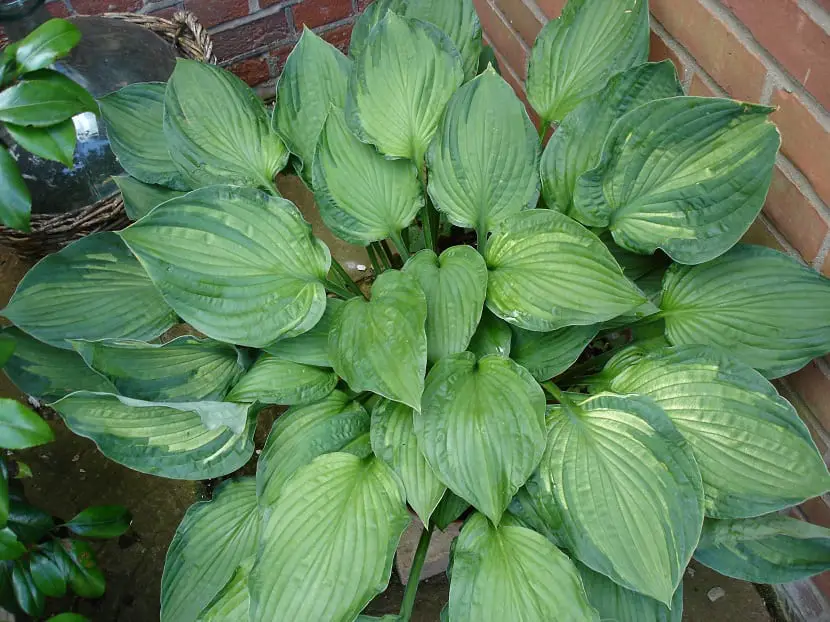

Today we are going to talk about the cough. These are plants that have leaves whose nerves are very marked and pointed. Its common name is beautiful since it has a great attractiveness thanks to that pronounced nervousness. The tone of the leaf and its size are striking and it does not need large flowers to have a great ornamental value. There are varieties of many types with colors that combine very well with other plants to create a good design in the garden.
With this article you can learn more about the hosta and what care it needs to stay alive and healthy.
Key features


The hostas they can reach a size of one and a half meters in diameter if they are cared for properly. Its flowering is quite attractive, although it does not need it to be a plant with high ornamental value. Flowering begins in early summer where some flower stalks emerge with some white bells that usually last a long time.
There is a wide variety of hostas on the market and the nuanced ones that are the most common are the ones that sell the most. This is because they have the periphery of the leaf with a white, cream or yellowish tone. This extra color on the edge of the leaves gives it better visibility and play with other colors for decoration. Being only leaves but that vary with that color, They can make color combinations themselves with other flowers without having to be flowered.
There are also other varieties that have a fairly intense bluish-green leaf that provides greater detail. These nuanced varieties of hostas look quite good and attractive if we place them in the shade. The white color offers luminosity in the darkest areas. It is perfect to place in places such as balconies and terraces facing the shade. In some darker areas of the garden it can also offer a good decoration if we combine it with some colorful plants that do get the sun’s rays.
Hostas requirements
To grow these plants in our garden we need to know certain requirements that it needs to be able to grow correctly. If we want the leaves not to wilt and the plant offers the highest quality, we must be attentive to the recommendations that we are going to give.
Location


Hosta growth improves greatly in climates where humidity is high. If your area does not have too much humidity, you can play with some shady space in the garden where, with other tall bushy plants, you can create areas of higher humidity. Thus, we are guaranteeing our plant enough humidity to have a good growth rate and a good quality in the leaves and flowers.
It is advisable to plant under a tree so that it provides shade and creates a small environment with humidity. You also have to know what variety we are planting, since there are some that are smaller in size and need more sunlight. The first thing is to know well the species that we are cultivating in order to be able to better guess the care it needs.
Land


An important aspect to take into account is the type of soil. Since it generally requires high humidity, it is essential that the soil can retain this humidity. Although they are not too demanding in terms of the type of soil, it is better if it has a high amount of organic matter. A loamy soil that has good moisture-holding capacity is good for hostas.
Do not confuse humidity with waterlogging. The plant needs moisture but without getting waterlogged. To do this, we must ensure that the soil has good drainage so that water does not accumulate when we water.
Regarding the pH, a more acidic pH is preferable. If we have a more calcareous soil, we must correct the type of soil with some type of compost or inorganic matter that acidifies the soil.
Irrigation and compost


To guarantee the growth and beauty of hostas, irrigation is the most conditioning factor. Humidity is important, as we have mentioned several times, both ambient and soil humidity. We can generate this with irrigation. Depending on the location of the plant, we can spray the environment so that, by itself, it can maintain the highest humidity.
Furthermore, watering also helps maintain a more favorable humidity environment if you find good drainage. Otherwise, we could cause our hosta to rot if irrigation water accumulates. Depending on the quality of the soil and the environment in which we have planted it, irrigation may be several times a week or less. If the humidity stays high, you won’t need as abundant watering.
The subscriber does not need any special conditions. Just keep in mind that you have to apply it generously. It is advisable to periodically add a handful of compost around the stem. In this way, we are replenishing the soil little by little, as it loses nutrients. With compost, we can also control the pH around the roots. This way it is possible to guarantee that it is slightly acidic as needed for optimal development.
Pests and multiplication


You may have heard that hostas, by maintaining an environment of both soil and ambient moisture, create a perfect comfort zone to attract snails and slugs. Well, it’s completely true. These leaves are like chocolate and candy for children and the not so young. If snails and slugs accumulate on the leaves of your hosta, you will need to use both organic and non-organic remedies to eliminate them.
The best technique is to manually remove them on a regular basisWe do not want to make these animals suffer either.
This plant is not usually pruned, but more than anything to cut the leaves that remain dry or wilted. It can be easily reproduced by division of the bush.
I hope that with this information you can take good care of the hosta in your garden.
